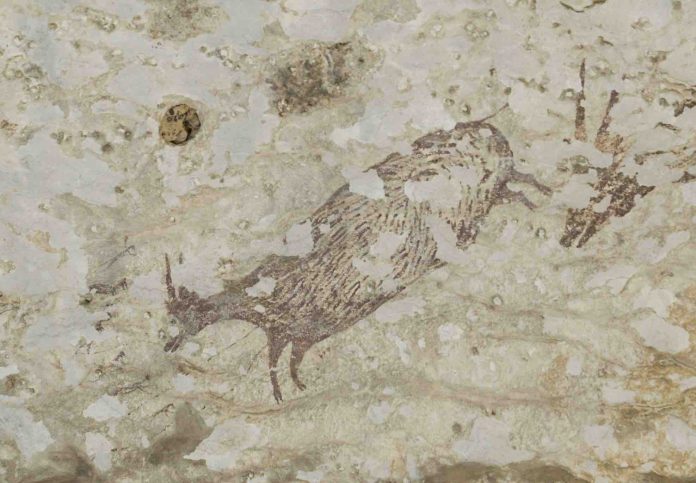A major discovery has been made in a limestone cave in Sulawesi, Indonesia – the earliest known hunting scene in the world has been identified on a hard to reach cliff face. At least 43,900 years ago someone decided to climb up into the cave and depict a group of human-like figures hunting pigs and buffaloes.
As soon as archaeologist Maxime Aubert, from Australia’s Griffith University, set eyes on the images, he was gob-smacked. “I’d never seen anything like it,” he says.
Aubert and colleagues have been conducting regular surveys of the limestone-rich region for several years, and it has proven to be a hot spot for some of the earliest cave art in the world.
More than 200 cave art sites have been documented so far. “Every year we find new sites,” says Aubert. “There’s hundreds of them; it’s quite amazing.”
In 2014, the same team found hand stencils and animal paintings in a nearby cave that were made at least 40,000 years ago. That finding shattered assumptions that rock art had its origins in Europe.
Last year, Aubert and colleagues also found rock art of a similar style and antiquity on the nearby island of Borneo
The new hunting scene is in a cave about 20 metres off the ground that was likely never used as a residence because of its location.
Aubert and his colleagues dated the artwork as at least 44,000 years old – the oldest so far – by measuring the amount of uranium and thorium in calcium carbonate nodules deposited on the painting’s surface.
The painting is noteworthy not only for its age, but also for what it depicts.
“We have a narrative scene – the first evidence of story-telling,” says Aubert, adding that this represents an important milestone in human cognitive evolution. Hunting scenes in the Lascaux cave in France date to much later – around 17,000 years ago.
“Now we’re more than doubling that,” he says.
The human-animal hybrids – people with animal tails or the heads like birds – are also significant because they indicate that whoever painted them could conceive of something that doesn’t actually exist, says Aubert, and could hint at the beginnings of human spirituality and religion.
The scene also shows what Aubert and his team believe are ropes tied around the neck of a pig. It’s a tantalising find, which could solve the mystery of who domesticated pigs.
European pigs (Sus scrofa) were domesticated in the Near East around 8000 years ago, but a second domestication event likely took place in Asia. When and where that happened remains a mystery.
It could be that people were already making attempts to tame and domesticate the beast on Sulawesi 44,000 years ago.
Archaeologists are now racing against time and the elements to see what other discoveries the Indonesian caves hold. “[They’re] disappearing at an alarming rate,” says Aubert, “just flaking off and we don’t know exactly what’s happening.”
He and his colleagues are recording the artworks for posterity using 3D laser scanning and taking samples for dating in the handful of sites that have them.















